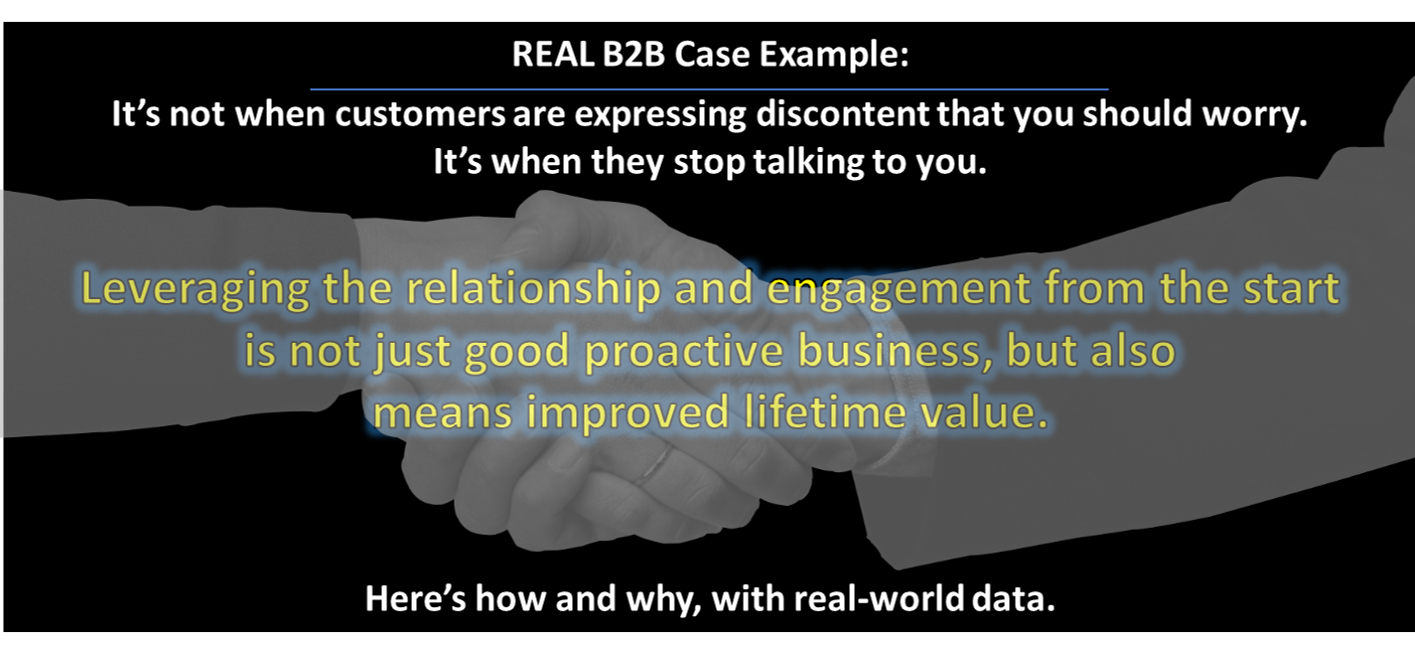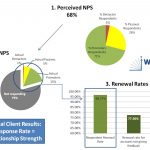A TopBox-client since 2015 asked us to help them predict future financial outcomes based on the operationalized B2B-customer feedback data that they had been harvesting over the past 4 years (here’s detail on how an “operationalized feedback program is executed). Having achieved steady improvement in customer engagement and sentiment with the same accounts and contacts over time (longitudinal trending), they wanted to leverage TopBox to predict future growth for better financial management:
- What rate of growth could they expect from the existing customer base?
- Which accounts are more likely to expand? And by how much?
- Which accounts are more likely to churn?
And since they had 4 years of customer feedback from “Buying Committee” members – not just end users or champions, but feedback from those people participating in buying decisions – the analysis was straightforward.
The findings are striking, yet similar to what we typically see when doing this exercise:
- 76% of the accounts that churned did not provide feedback (i.e. not responding to feedback requests or joint account planning processes). Although these accounts have been using the products, they’ve been otherwise silent.
- 69% of the customer-accounts that didn’t grow (accounts with 0% growth) over the last 4 years were also silent.
- This compares to 9% churn-rate for accounts that participated in the feedback process, regardless of whether the feedback was positive or negative!
Commentary: B2B customers that aren’t providing feedback are ~7 times more likely to churn than customers that are providing feedback (for this client… and across clients we tend to see this number between 3x to 14x depending on market- and customer-maturity). The take-away? Get customers to provide feedback! Here’s a whitepaper that explains how to engage customers and get them to participate. Not surprisingly, the earlier in a customer’s lifecycle you’re able to demonstrate that you care, the easier it is to keep them engaged. Further, success in this effort is closely linked with showing customers how you will action the feedback they provide… which leads us to #2…
2. Accounts are more likely to expand when either (1) their own NPS is high and flat (happy/successful and stay that way) or (2) improving over time (initially unhappy but improved as our client addressed their feedback):
- Of the accounts that grew by 10% or more, the majority (56%) showed flat or improving NPS from the Buying Committee members.
- Only 14% of the accounts that declined in NPS (overall sentiment) had positive (expansion) growth.
Commentary: A snapshot of customer sentiment in time doesn’t give you the picture. It’s the longitudinal trending (how the same contacts and accounts feel about the relationship over time) that provides the early-warning signal for effective action. In other words, it’s how your company responds to feedback that is critical. This Enterprise-SaaS company has done a fabulous job of listening and address customers’ feedback by operationalizing feedback processes to align with ‘ journey.
To sum up what matters most:
- Whether the right people in the account are providing your company with feedback (and this client sees account participation at 50%+ … yes, representative and trustworthy feedback can really happen when properly engaging your customers), and
- How your company responds to that feedback.
Despite the fact that this client didn’t necessarily hear anything new in the feedback they were getting, allowing customers to have a real voice provided an opportunity for customers to feel heard. “When we feel heard, we feel the other party is on our side. When we don’t feel heard, it’s us vs. them.”
You’re missing the boat if you’re only looking at sentiment and customer feedback as a “point in time” exercise. Since we know that the world of B2B is characterized by long-lasting relationships and outcomes (not just individualized experiences), longitudinally trending the same accounts and contacts over time that provides critical insight that can tell you if the account is in jeopardy or ripe for expansion.
Bottomline: By improving customer-participation and formalized feedback processes (programs) you’d
- Gain solid early-warning indicators that can reduce churn
- Identify more expansion opportunities
These results are consistent with what we typically find: Silent customers are far more likely to churn and far less likely to expand. Engaging Buying Committee members by seeing what they perceive to be working well / not working well is not only a powerful tool to drive growth in your customer base, but can also serve as a method to better predict resource requirements in the future. Put proactive engagement methods in place to just make customer feedback work for you.
Here’s more information on how an “operationalized feedback” (“Customer Engagement”) program works. And I love collaborating with real-world practitioners so please connect with me or contact us to learn more.



